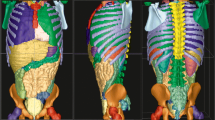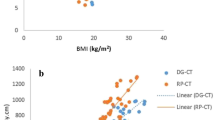Abstract
Background
There is a benefit in characterizing radiation-induced cancer risk in pediatric chest and abdominopelvic CT: a singular metric that represents the whole-body radiation burden while also accounting for age, gender and organ sensitivity.
Objective
To compute an index of radiation risk for pediatric chest and abdominopelvic CT.
Materials and methods
Using a protocol approved by our institutional review board, 42 pediatric patients (age: 0-16 years, weight: 2-80 kg) were modeled into virtual whole-body anatomical models. Organ doses were estimated for clinical chest and abdominopelvic CT examinations of the patients using validated Monte Carlo simulations of two major scanner models. Using age-, size- and gender-specific organ risk coefficients, the values were converted to normalized effective dose (by dose length product) (denoted as the k factor) and a normalized risk index (denoted as the q factor). An analysis was performed to determine how these factors are correlated with patient age and size for both males and females to provide a strategy to better characterize individualized risk.
Results
The k factor was found to be exponentially correlated with the average patient diameter. For both genders, the q factor also exhibited an exponential relationship with both the average patient diameter and with patient age. For both factors, the differences between the scanner models were less than 8%.
Conclusion
The study defines a whole-body radiation risk index for chest and abdominopelvic CT imaging, that incorporates individual estimated organ dose values, organ radiation sensitivity, patient size, exposure age and patient gender. This indexing metrology enables the assessment and potential improvement of chest and abdominopelvic CT performance through surveillance of practice dose profiles across patients and may afford improved informed communication.




Similar content being viewed by others
References
Bahador B (1996) Trends in diagnostic imaging to 2000. Urch Publishing, London
IMV (2012) CT Market Outlook Report. IMV Medical Information Division, Des Plaines, IL
Brenner DJ, Hall EJ (2007) Computed tomography--an increasing source of radiation exposure. N Engl J Med 357:2277–2284
McCollough CH, Chen GH, Kalender W et al (2012) Achieving routine submillisievert CT scanning: report from the summit on management of radiation dose in CT. Radiology 264:567–580
Goske MJ, Applegate KE, Boylan J et al (2008) The image gently campaign: working together to change practice. AJR Am J Roentgenol 190:273–274
Pearce MS, Salotti JA, Little MP et al (2012) Radiation exposure from CT scans in childhood and subsequent risk of leukaemia and brain tumours: a retrospective cohort study. Lancet 380:499–505
National Research Council (2006) Health risks from exposure to low levels of ionizing radiation — BEIR VII. The National Academies Press, Washington, DC
Goske MJ, Applegate KE, Boylan J et al (2008) Image gently(SM): a national education and communication campaign in radiology using the science of social marketing. J Am Coll Radiol 5:1200–1205
McCollough CH, Leng S, Yu L et al (2011) CT dose index and patient dose: they are not the same thing. Radiology 259:311–316
AAPM (2011) Size-specific dose estimates (SSDE) in pediatric and adult body CT examinations, AAPM report no. 204. American Association of Physicists in Medicine, College Park, MD
Kalender WA (2014) Dose in x-ray computed tomography. Phys Med Biol 59:R129–R150
Martin CJ (2007) Effective dose: how should it be applied to medical exposures? Br J Radiol 80:639–647
McCollough CH, Christner JA, Kofler JM (2010) How effective is effective dose as a predictor of radiation risk? AJR Am J Roentgenol 194:890–896
International Commission on Radiological Protection (2007) The 2007 recommendations of the international commission on radiological protection, ICRP publication 103. Essen, Germany
Bogdanich W (2009) Radiation overdoses point up dangers of CT scans. In the New York Times. Available at: http://www.nytimes.com/2009/10/16/us/16radiation.html
Bogdanich W (2011) West Virginia hospital over radiated brain scan patients, records show. In the New York Times. Available at: http://www.nytimes.com/2011/03/06/health/06radiation.html?_r=3
Brenner DJ (2008) Effective dose: a flawed concept that could and should be replaced. Br J Radiol 81:521–523
Lee C, Lee C, Staton RJ et al (2007) Organ and effective doses in pediatric patients undergoing helical multislice computed tomography examination. Med Phys 34:1858–1873
Hurwitz LM, Reiman RE, Yoshizumi TT et al (2007) Radiation dose from contemporary cardiothoracic multidetector CT protocols with an anthropomorphic female phantom: implications for cancer induction. Radiology 245:742–750
Hendee WR, O'Connor MK (2012) Radiation risks of medical imaging: separating fact from fantasy. Radiology 264:312–321
Dorfman AL, Fazel R, Einstein AJ et al (2011) Use of medical imaging procedures with ionizing radiation in children: a population-based study. Arch Pediatr Adolesc Med 165:458–464
Li X, Samei E, Segars WP et al (2011) Patient-specific radiation dose and cancer risk estimation in CT: part II. Application to patients. Med Phys 38:408–419
Segars WP, Mahesh M, Beck TJ et al (2008) Realistic CT simulation using the 4D XCAT phantom. Med Phys 35:3800–3808
Segars WP, Sturgeon G, et al (2009). Patient specific computerized phantoms to estimate dose in pediatric CT. SPIE Proceedings, p 72580H
ICRP (2002) Basic anatomical and physiological data for use in radiological protection: reference values, ICRP publication 89. International Commission on Radiological Protection, New York
Baro J, Sempau J, Fernandez-Varea JM, Salvat F (1995) PENELOPE: an algorithm for Monte Carlo simulation of the penetration and energy loss of electrons and positrons in matter. Nucl Instrum Meth B 100:31–46
Sempau J, Fernandez-Varea JM, Acosta E, Salvat F (2003) Experimental benchmarks of the Monte Carlo code PENELOPE. Nucl Instrum Meth B 207:107–123
Li X, Samei E, Segars WP et al (2011) Patient-specific radiation dose and cancer risk estimation in CT: part I. Development and validation of a Monte Carlo program. Med Phys 38:397–407
Tian X, Li X, Segars WP et al (2014) Pediatric chest and abdominopelvic CT: organ dose estimation based on 42 patient models. Radiology 270:535–547
Li X, Samei E, Segars WP et al (2011) Patient-specific radiation dose and cancer risk for pediatric chest CT. Radiology 259:862–874
Dougeni E, Chapple CL, Willis J et al (2011) Assessment of effective dose in paediatric CT examinations. Radiat Prot Dosim 147:147–150
Kleinman PL, Strauss KJ, Zurakowski D et al (2010) Patient size measured on CT images as a function of age at a tertiary care children's hospital. AJR Am J Roentgenol 194:1611–1619
The State of California SB 1237 (2010) Available at: http://www.leginfo.ca.gov/pub/09-10/bill/sen/sb_1201-1250/sb_1237_bill_20100929_chaptered.html
Hendrick RE, Dodd GD 3rd, Fullerton GD et al (2012) The University of Colorado Radiology Adult Dose-Risk Smartcard. J Am Coll Radiol 9:290–292
The Joint Commission (2011) Sentinel Event Alert, Issue 47, Aug 24, 2011
Dietze G, Harrison JD, Menzel HG (2009) Effective dose: a flawed concept that could and should be replaced. Comments on a paper by D J Brenner (Br J Radiol 2008;81:521-3). Br J Radiol 82:348–350 author reply 350-341
Pradhan AS, Kim JL, Lee JI (2012) On the use of "effective dose" (E) in medical exposures. J Med Phys 37:63–65
American Association of Physicists in Medicine (2011). AAPM position statement on radiation risks from medical imaging procedures Available at http://www.aapm.org/org/policies/details.asp?id=318&type=PP
Brenner DJ, Hall EJ (2012) Cancer risks from CT scans: now we have data, what next? Radiology 265:330–331
Alessio AM, Phillips GS (2010) A pediatric CT dose and risk estimator. Pediatr Radiol 40:1816–1821
Colagrande S, Origgi D, Zatelli G et al (2014) CT exposure in adult and paediatric patients: a review of the mechanisms of damage, relative dose and consequent possible risks. Radiol Med 119:803–810
Peck DJ, Samei E (2017) American College of Radiology: How to understand and communicate radiation risk. http://www.imagewisely.org/imaging-modalities/computed-tomography/medical-physicists/articles/how-to-understand-and-communicate-radiation-risk. Accessed 07 Aug 2017
Deak PD, Smal Y, Kalender WA (2010) Multisection CT protocols: sex- and age-specific conversion factors used to determine effective dose from dose-length product. Radiology 257:158–166
Fletcher JG, Kofler JM, Coburn JA et al (2013) Perspective on radiation risk in CT imaging. Abdom Imaging 38:22–31
Author information
Authors and Affiliations
Corresponding author
Ethics declarations
Conflicts of interest
None.
Rights and permissions
About this article
Cite this article
Samei, E., Tian, X., Paul Segars, W. et al. Radiation risk index for pediatric CT: a patient-derived metric. Pediatr Radiol 47, 1737–1744 (2017). https://doi.org/10.1007/s00247-017-3973-z
Received:
Revised:
Accepted:
Published:
Issue Date:
DOI: https://doi.org/10.1007/s00247-017-3973-z




